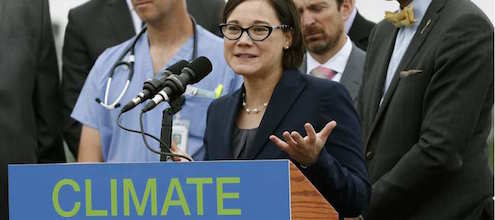
Alberta takes the lead with carbon pricing policy
by Bev Dahlby, Jim Dinning and Chris Ragan
Last week, Alberta introduced legislation to enable its new policy for reducing greenhouse-gas emissions. At the core of the policy is an economy-wide carbon price that will generate revenues to be recycled back into the economy. The bottom line, at least based on what we know so far, is that the legislation is offering sensible ecofiscal policy for Alberta.
Alberta’s GHG emissions are the highest and fastest growing in Canada. Slowing and then reducing these emissions can make a contribution to global efforts, which help to avoid the costs of a warming climate — costs that are already tangible in Alberta and across Canada. And putting a price on GHG emissions is a clear signal to the world that Alberta is adopting sound ecofiscal policies to meet its environmental responsibilities.
Economists from Canada and elsewhere have loads of evidence that prices change behaviour, and that’s the point of a carbon price. Alberta’s carbon price will be $20 per tonne in 2017, rising to $30 in 2018. For households and businesses, this carbon price will cause a multitude of small and large decisions that will reduce GHG emissions.
Businesses will change the way they do things. The composition of commercial vehicle fleets may be adjusted to be more fuel efficient, or even electric. Consumers in the market for a new furnace will see that a more efficient model might make a lot more sense. Ditto for those considering new cars or trucks.
Some will argue that a carbon price needs to be higher than $30 per tonne, but they are wrong. Few consumers and businesses make these decisions overnight, but over time the new decisions happen. A higher carbon price will be necessary to drive deeper GHG reductions in future, but Alberta’s new carbon price is an excellent start.
Carbon pricing is cost effective — meaning that it achieves emissions reductions at the lowest possible cost to the economy. The Alberta government could have chosen to regulate emitters to use specific low-carbon technologies or to achieve a given level of emissions performance. But in fact, regulations cost more than a carbon price, because they reduce the flexibility emitters have to find the cheapest way to reduce emissions.
A carbon price encourages emitters to find innovative ways to avoid paying the tax, because the gain goes straight to their bottom line. In addition, a carbon price provides an ongoing incentive to find ways to reduce emissions, and this can be a powerful force for driving long-run innovation.
A key element of the new policy is to extend the carbon price to GHG emissions from large industrial emitters and individual, car-driving, home-owning Albertans. Because let’s remember: we’re all emitters. Broadening the scope of carbon pricing is another way to achieve more emissions reductions at lower cost. By applying the price to roughly 85 per cent of provincial emissions, fewer low-cost opportunities to reduce emissions are “left on the table.”
No discussion of carbon pricing is complete without mentioning how the revenues are recycled back into the economy. Alberta’s policy is projected to generate more than $3 billion in revenues in 2018, and this number will almost certainly increase over the next several years. This revenue provides a turning-point opportunity.
No single approach to revenue recycling can do it all. Facing some difficult but inevitable trade-offs, what has Alberta chosen? Alberta will use its carbon-pricing revenue to support additional emissions reductions, reduce the small business tax rate, and provide rebates to low-and-middle income families. These rebates reduce the burden to households without weakening their incentive to cut emissions.
Where does all of this leave Alberta? The new policy moves Canada’s highest-emissions province toward the head of the pack with a stringent, cost-effective and sensible climate policy. There will be more to do in the future — and deeper emissions reductions to achieve. But Alberta’s new policy shows the world that being an emissions-intensive economy does not stand in the way of having a smart carbon-pricing policy.
The Canadian Ecofiscal Commission is independent and aims to serve policy-makers across the political spectrum. Christopher Ragan is chair of the Commission. Economist Bev Dahlby is a commissioner. And former Alberta Treasurer Jim Dinning is an adviser to the Commission.
This piece was originally published in the Edmonton Journal on May 31, 2016.




Comments are closed.